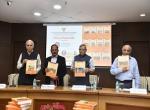A webinar was held on August 26, 2020 where the main speaker, Prof. Shashi Prabha Kumar, Dean, Sri Sankaracharya Sanskrit Mahavidyalaya, Bhartiya Vidya Bhavan gave her second lecture in the series, Indian Philosophy for Beginners, organised by the Vivekananda International Foundation. This talk was titled Environmental Awareness in the Vedas.
The event began with opening comments by Dr Arvind Gupta, Director VIF, where he highlighted the need to change the western mindset of overcoming or conquering nature with the help of our ancient thought in the context of climate change and the existential threat it poses to mankind. Dr. Gupta thus highlighted the importance of adopting and understanding the kind of respect given to the environment in our Vedas.
Prof. Shashi Prabha Kumar began the lecture with the definition of environment as given in the Environment Protection Act, “environment includes water, air and land and the interrelationship which exists among and between water, air and land, and human beings, other living creatures, plants, micro-organism and property;” and its main classification into solid, liquid and gas or the lithosphere, hydrosphere, atmosphere and biosphere. Keeping the modern definition and classification of the environment in mind, Professor Kumar moved towards the Vedic understanding of environment. She noted that the Sanskrit word for the environment is paryavarana which is different from the word vatavarana (atmosphere) as the paryavarana includes the vatavarana and everything that encompasses us. The distinguishing aspect of Vedic philosophy according to Professor Kumar is the inter relations within the aspects of nature explained within it.
The Vedas propound that all of us (every entity of nature), especially the human beings (as we are the overtly conscious ones) must have friendly relations with each aspect of nature. While the Vedas don’t deny the attitude of indulgence and gratification towards nature, they do say that this attitude should be restrained. We must take and enjoy only as much as we need but not more than that as no amount can ever satiate out greed. This is something that even Mahatma Gandhi practiced. The main idea is to have a reciprocal approach towards the cosmic existence. In other words, when we approach nature, we must approach it with reverence and not only as a resource. The other factor the Vedas talk about is enjoying nature with tyag bhava. The wealth of natural resources does not belong to anybody and must be shared with everyone.
The pandemic has proved that for nature there is no geographic boundary and the effects of nature reaches everybody. Professor Kumar described the Vedas as beyond the borders of religion, geographical boundaries etc. UNESCO in its memory of world register 2007 stated, “The Vedas are generally known as the scriptures of the Hindu community. However, being among the first literary documents in the history of humankind, they transcend far beyond their identity as scriptures”. With this quote Professor Kumar explained that we have to locate and explore all those aspects of the Vedas that are valuable for us, the cosmic existence as well as harmony.
The prithvi sukta of the Atharvaveda is one of the most important resources we have from the Vedas. Earth in this hymn is symbolic of everything that grows on it. It invokes all the physical and non-physical aspects of nature within its verse. It depicts not only the forms of nature's aspects but its underlying emotional bonding with them. It describes the earth as one’s mother, the sky as one’s father, and the moon as one’s brother and so on. This is not just the personification of nature but also a description of a way of life. At the same time, three spheres of the universe have been enumerated in the Vedic philosophy expressed in the prithvi sukta, the ground to the solid earth, the intermediary or the mid-space and the uppermost or the celestial. The Vedas say that all these spheres exist within and outside of the body. By considering the forces of nature as divine, our ancestors were respectful and mindful towards nature. This is something that has been lost in our greed. Nature has two aspects, the benign aspect and the fierce aspect as seen in its form of natural resources and natural disasters. Today's natural disasters are not something normal. They are a warning to mankind that the laws of nature have to be followed. It is therefore the duty of academicians and intellectuals to explore and propagate such ideas to the masses and encourage them to apply these ideas in a practical manner in their day to day lives as was done by our previous generations.
The prithvi sukta gives us the six factors that can sustain earth: satyam brihat (care for self and others), ritam ugram (the cosmic law and rhythm of nature which if crossed or disregarded leads to the fierce form of nature), diksha (dedication towards maintaining the balance of nature), tapaha (concentrated effort towards the mission of diksha), brahma (adjective of the ever evolving dynamic knowledge which has a neutral gender and is derived from the root bhringah, that which grows and evolves with time) an lastly yajna (it is the key concept of vedic script for maintaining and sustaining the environment. It puts the vedic teachings in practice as rituals, for e.g. planting a tree, watering a particular plant etc. Overall, it is offering oneself for the collective good. It is derived from the root yaj, i.e., propitiating the divine, communitarian sharing as well as sharing of resources. Following this, there are 5 types of yajna that have been prescribed for every house holder, brahma yajna, i.e., reading and gathering knowledge for the benefit of humanity, deva yajaya, i.e., the rituals that signify replenishing nature, pitri yajna, i.e., respecting and taking care of the elders in the family as well as the society, atithi yajna, i.e., respect to the guests who come into your home and finally bhuta yajna, i.e., respect for all flora and fauna.
Lastly, Professor Kumar put forward a point that even if we don’t believe in the religiosity of these acts, we can practice it simply for the environment and our own well-being. She cited the example of homa therapy and the research being done on it by Indian and German researchers, where use of this therapy has shown proven results in the context of agriculture and human well-being.
A brief discussion took place at the end of the webinar about ways to make the concepts in the Vedas transcend religious or geographical boundaries and make them a universal practice like yoga. It was observed that our real needs in life are not that much as observed during the time of the lockdown where people were able to live with much less. Humanity came up with the concept of money but even the richest person in the world would not be satisfied in life. Our ancestors had realised long time ago that the real wealth is that of nature and satisfaction can only be achieved by having a healthy environment. If we look at Nighantu, the very first dictionary of the Vedas which defines the terms that were used in the Vedas, we see that in the Vedas, there are 21 names of earth and 101 names for water as it was observed in its different forms. This shows how close to nature our ancestors were. Implementation of Vedas can only be propagated if everyone starts practicing these teachings at an individual level. This will allow us to lead by example and spread awareness at least around us and in turn revitalise our society.






Post new comment